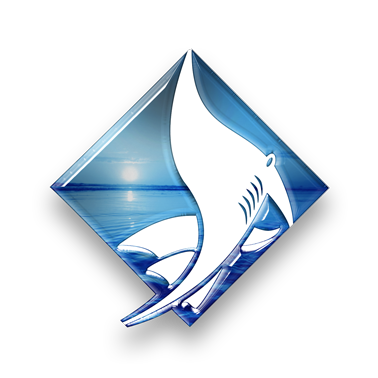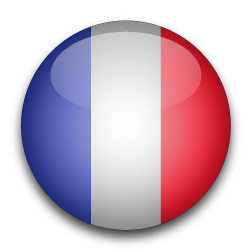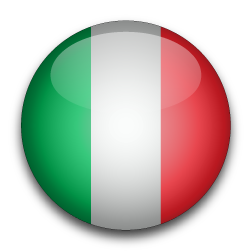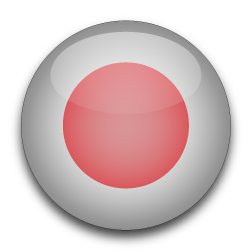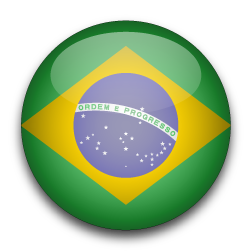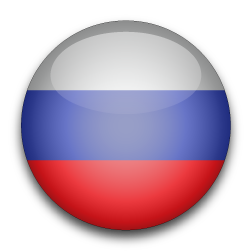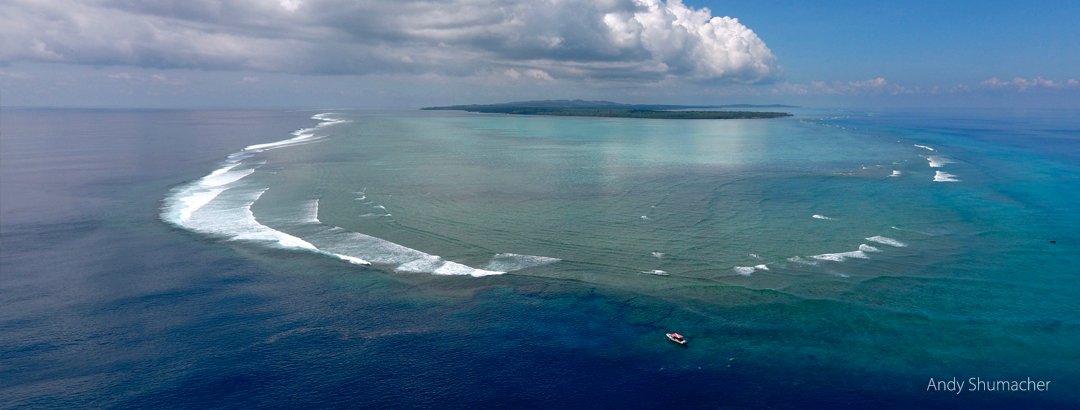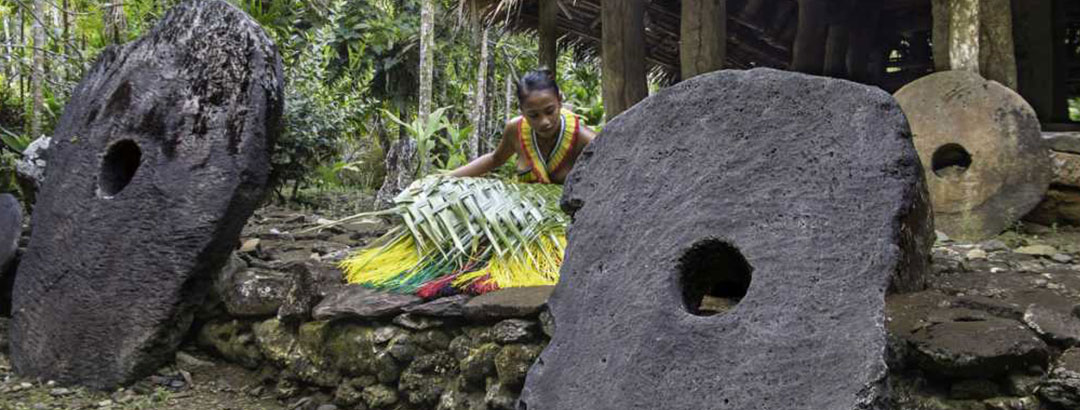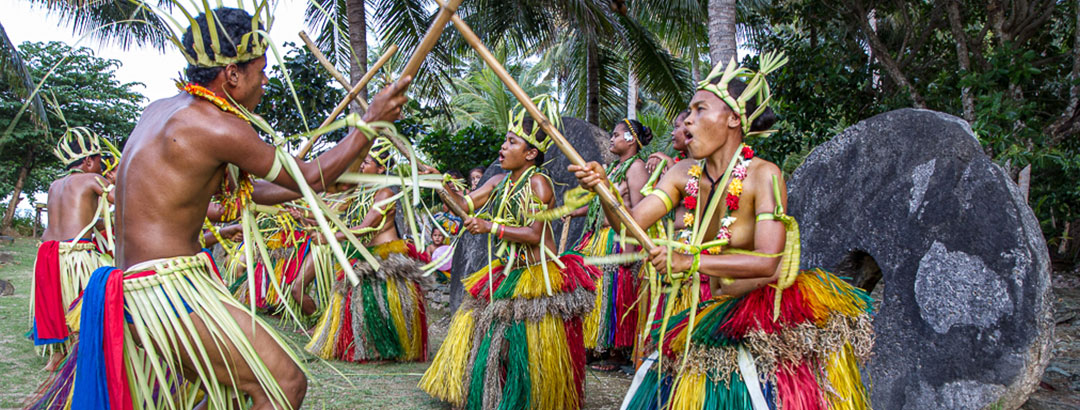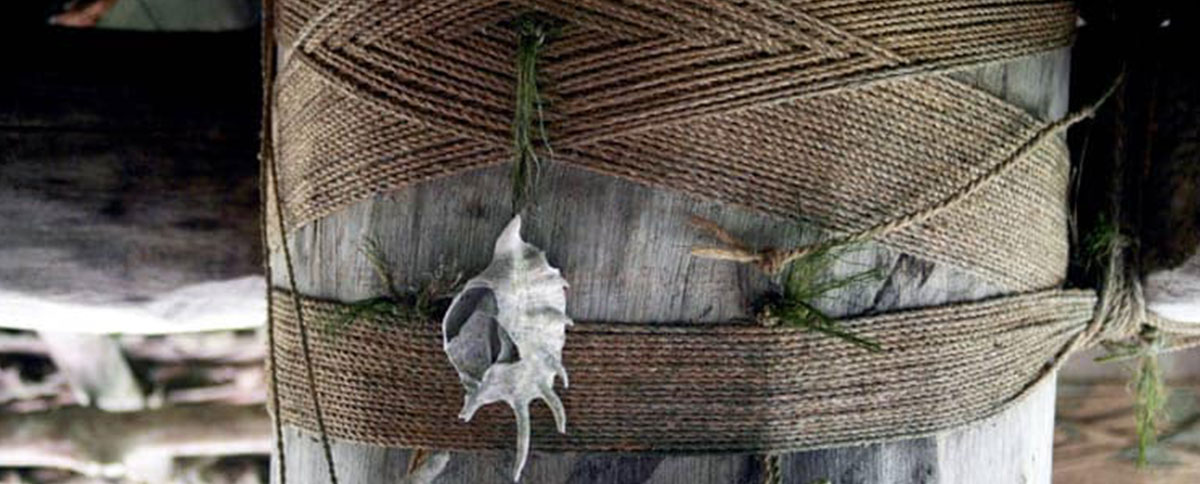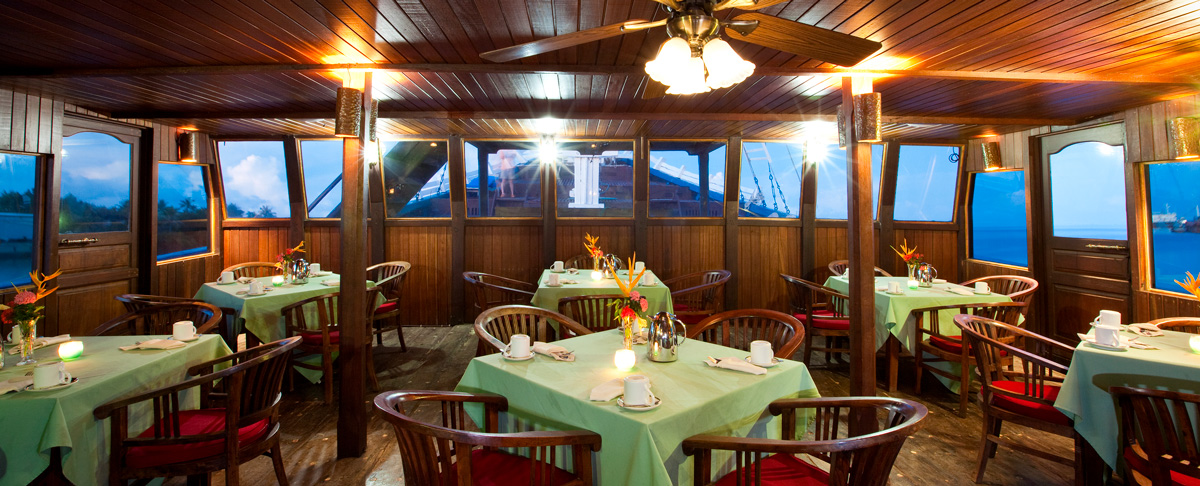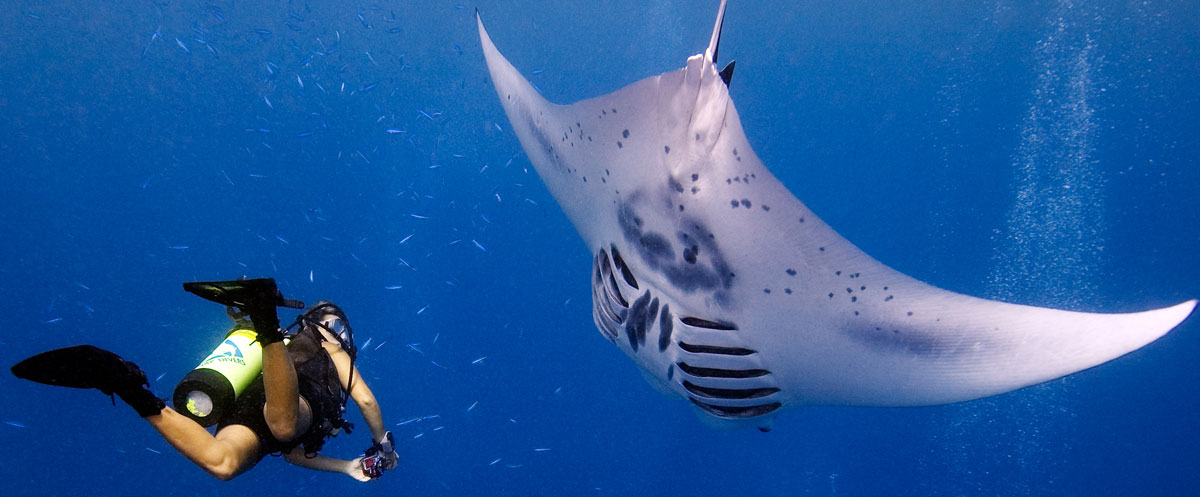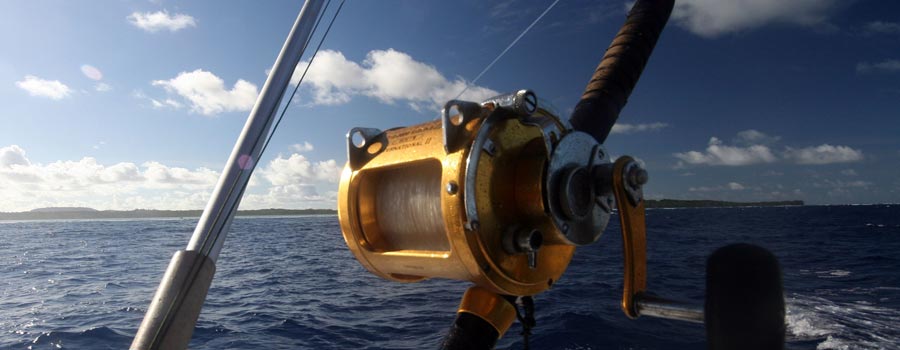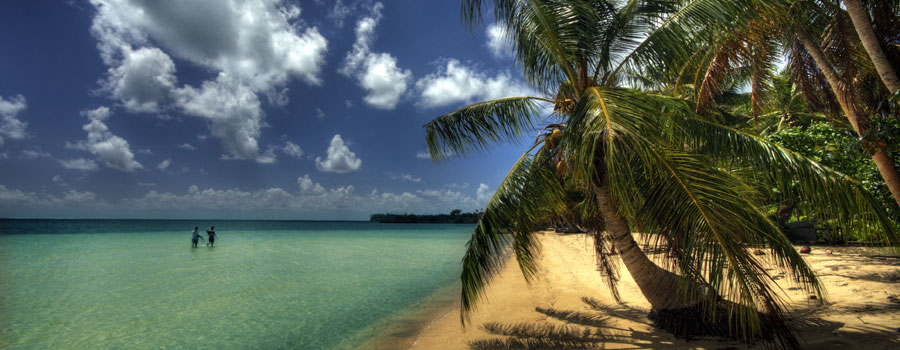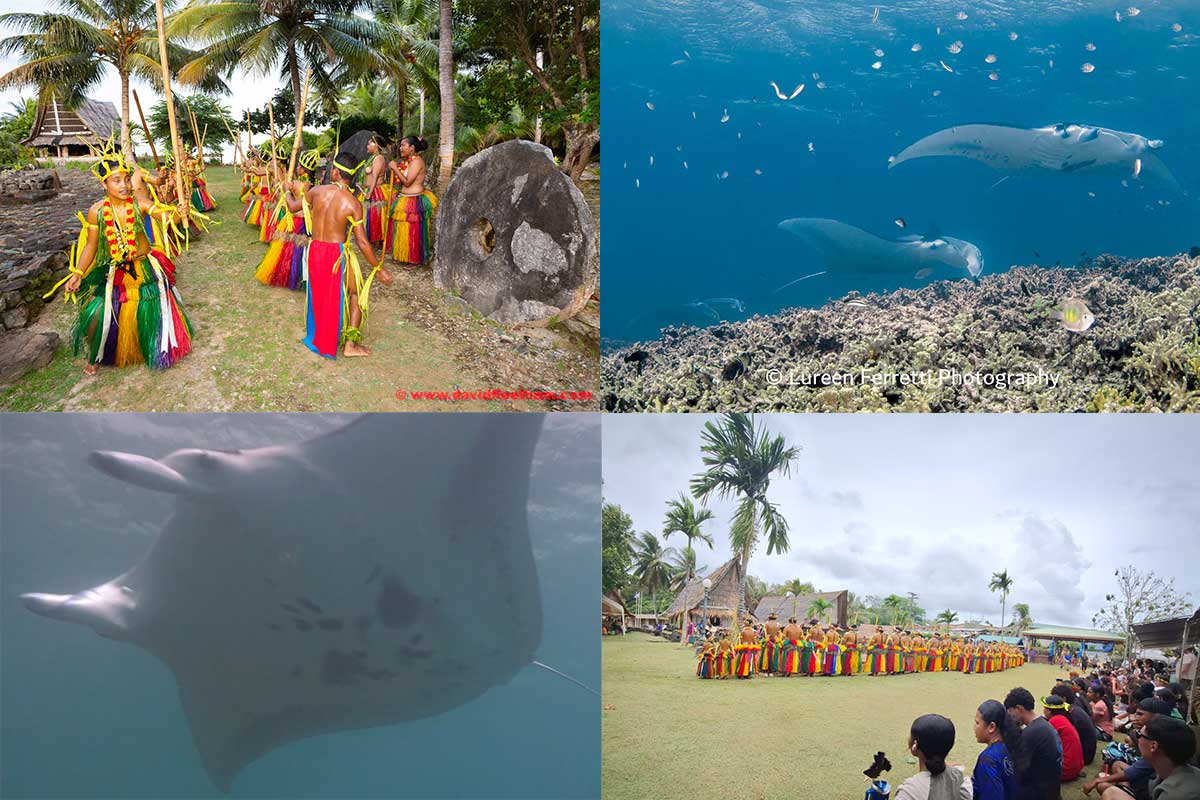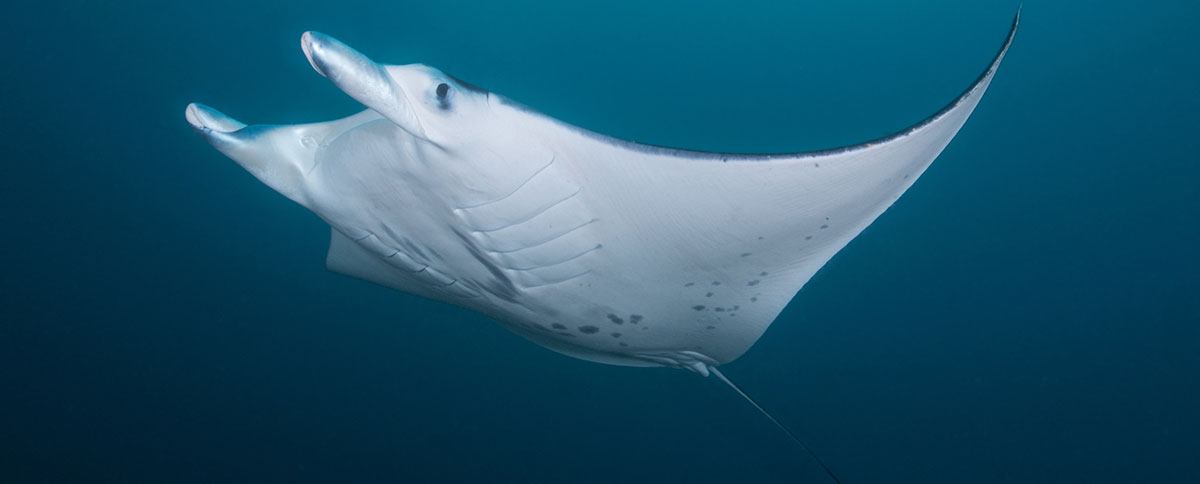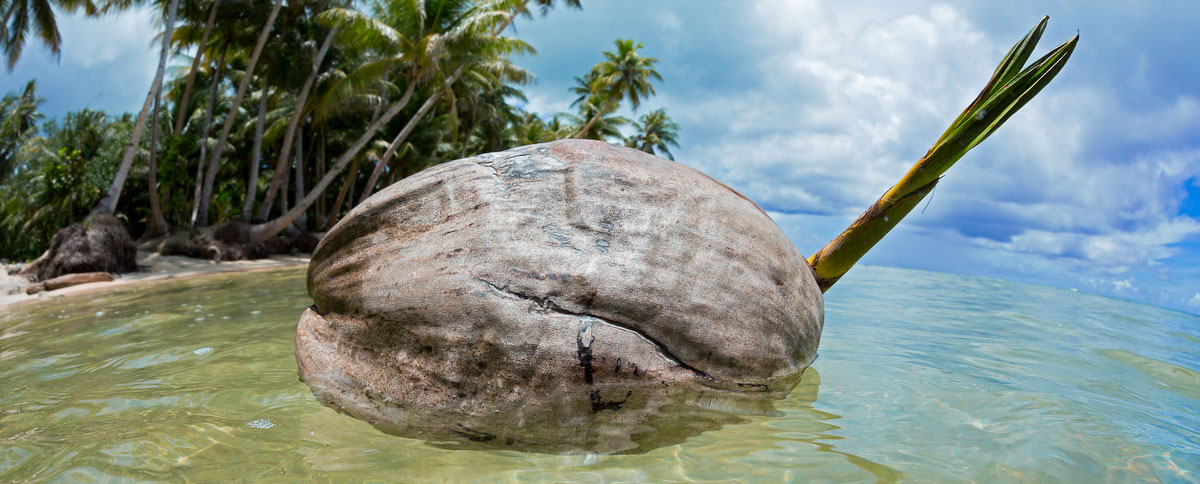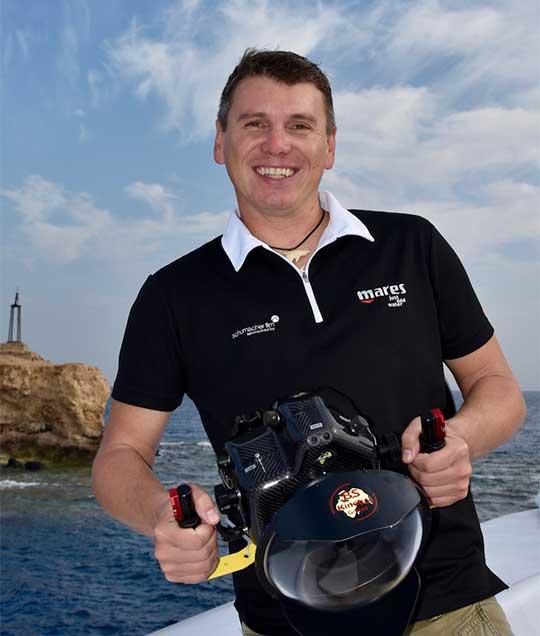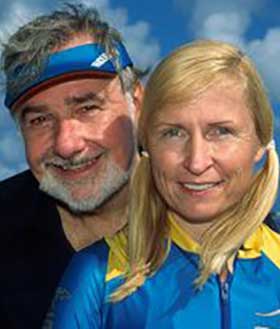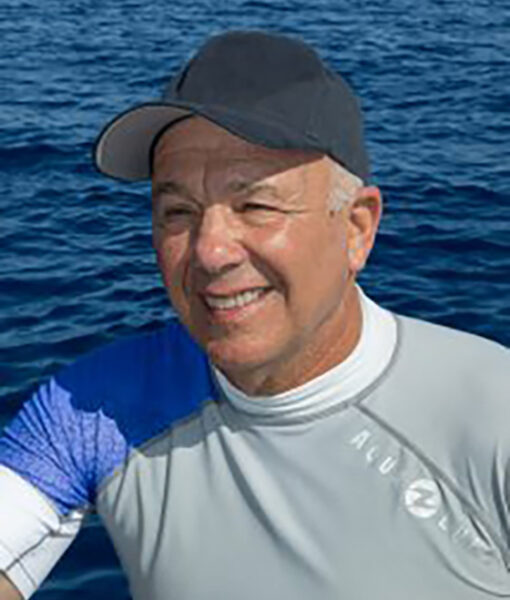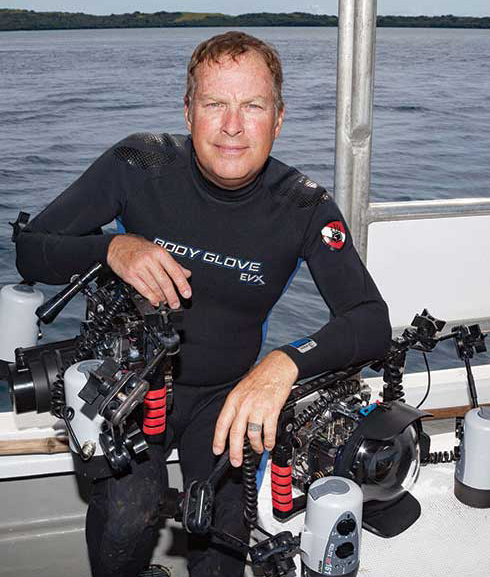Andy Schumacher
Andreas Schumacher (nicknamed Andy) was born May 23, 1977, in Neuss, Germany. Andy began diving in 2000 in Thailand and currently has just a short of 2,200 logged dives.
An independent filmmaker since 2005, Andy has produced promotional videos for Blue Planet Liveaboards, Emperor Divers Maldives and Indonesia, Manta Ray Bay Resort & Yap Divers, Sam’s Tours, Sinai Divers Egypt, Sea Bees Thailand, European Diving School France, Blue Adventure Diving Spain, Divin’Giens France, SMY Ondina Indonesia, Meridia Dive & Relax Maldives and more.
Andy uses a Panasonic Lumix GH5S in BS Kinetics underwater housings. He also shoots with the DJI Mini 4 Pro for aerial shots. Andy has been a Mares opinion leader since 2006 and is the Mares representative and video pro presenter at the annual MantaFest in Yap, Micronesia, and is a partner with Taucher.net.
I first met Andy at the annual BOOT Show held each January in Düsseldorf, Germany. Andy is a good friend of our German Marketing person, Mr. Daniel Brinkmann. Daniel and I were approaching Mares to dive gear company about sponsorships for our annual MantaFest Photo School & Competition and Andy was also there waiting to have his own meeting with them.
While waiting, we began chatting and realized that we had a lot in common, knew a lot of the same people and from that day, over 10 years ago, we have become really close friends. Andy is very personable and knowledgeable and a real pleasure to spend time with. Come meet him in person during one of our upcoming MantaFest programs. For more information and Andy’s work please visit schumacherfilm.de or schumacherfilm on Instagram.
Frank Schneider
Born in December 1958, Frank grew up in the western part of Germany close to Düsseldorf. His fascination with oceans and marine life grew while watching Jacques Cousteau’s TV series “The Undersea World of Jacques Cousteau” together with his Grandmother. As their family lived far away from any sea, his Grandma saw the ocean only once in the late years of her life. Young Frank decided that one day he would explore the underwater world and show his family photos from below the surface.
After years of working in military aviation, where he increased his skills in the English language, Frank married in his mid-twenties. His wife Ursula soon shared his passion for the underwater world and since then is featured as an underwater model in many of his images.
His first article was published in 1983, which eventually turned out to be the starting point for Frank’s career as a travel journalist. His articles have been published in many countries, including Italy, Spain, England, Norway, Denmark, the Netherlands, Austria, Switzerland, Russia, Turkey, and Croatia.
Together with their friend Leda Monza from Milano, Italy, who also became one of his uw-photo models, Frank learned to speak Italian while co-writing with Leda, the “Encyclopedia of Diving” in Italian. Books of Frank (dive travel guides, encyclopedia, U/W-photo school, and many more) are published in Germany, Great Britain, and in cooperation with Leda also in Italy.
Since 2015, together with his friend and colleague Paul Munzinger, he is the publisher and editor of the German Online magazines www.divingeurope.de and www.diving7seas.de. Both magazines have produced a Special Edition on Yap and Manta Ray Bay Resort & Yap Divers in English. It can be downloaded for free at https://joom.ag/sina
For his job, Frank uses two digital Nikon-SLR-cameras, a Nikon D850 and a Nikon D3X as well as several original Nikon lenses. Those Nikon lenses range from a 16 mm fisheye up to the tele zoom VR 70-200 mm, all of which have a 2.8 f-stop. For his U/W photography, the Nikon D850 in a Seacam housing together with the Nikon f2,8/16 mm fisheye lens, the f2,8/14-24 mm wide-angle zoom from Nikon, and the Nikon 60 mm and 100 mm macro lenses are Frank’s standard photography equipment. One or two Seacam Seaflash 150 TTL strobe lights take care of light and color.
I met Frank because I have been fortunate to exhibit at the massive German BOOT Show in Düsseldorf every year for the past 30 some odd years. Early on, I would stand in my booth and ogle all the famous people walking the isles and when I would walk around, I would see even more famous people in their booths. A common sight was one guy, with a massive camera, running around like crazy taking pictures of everyone. I was always a bit envious and hopeful that one day I would be well enough known in Europe for him to stop and take my picture. I finally got up the nerve to ask someone who he was and was told “that’s Frank Schneider, the photographer for Tauchen Magazine” (the largest in Europe at the time). One day in about 2009 or so, the timing was just right that Frank was taking a picture of someone in our booth and I was introduced to this stalwart of photography. Turns out he was and is a great guy and we hit it off immediately. Shortly Frank was sent to Yap to do a feature story on the island, and our diving, by the editors of Tauchen. We spent two weeks diving Yap together and our friendship has grown with each passing year.
Paul Tzimoulis & Geri Murphy
Paul Tzimoulis is regarded as one of the founding fathers of the recreational diving industry in the USA, as well as a significant influence on diving worldwide. As Publisher and Editor of the world’s largest and best read diving magazine, Skin Diver Magazine, he has had a profound influence on the sport. He guided every field from equipment development to training, safety, diving certification, travel, and technique. His provocative editorials, stimulating articles, and incredible photographs have done much to elevate the quality of SKIN DIVER Magazine and diving in general.
Paul devoted his entire life to a career in diving. He began snorkeling and free diving in the freshwater lakes of Connecticut while still a high school teenager. Tzimoulis purchased his first regulator in 1955 and quickly became a scuba instructor, dive club president, dive shop owner, and early commercial diver.
In 1960 Tzimoulis joined U.S. Divers Co and became Customer Service Manager. The following year he was employed at Sportsways where he served as a sales rep for the entire eastern United States.
In 1964 Paul accepted a position at the New York office of Petersen Publishing as Sales Representative for Skin Diver Magazine. Two years later, Paul became Editor & Publisher of the magazine, relocated to California, eventually becoming Group Publisher and Vice-President.
Paul was Publisher of Skin Diver Magazine for almost 35 years, generating hundreds of articles and photographs, developing a small obscure publication to a mega powerhouse magazine that became the largest diving magazine in the world. He lived a lifestyle that most divers can only imagine. Visiting tropical dive resorts in the Caribbean & Pacific, he was “living the dream.” Paul was a prolific writer, lecturer, photographer, and teacher. He also co-authored a book on underwater photography entitled Camera Below in 1968.
In 1964, the International Underwater Film Festival held in Santa Monica, California acclaimed Tzimoulis as, “the brightest young meteor on the horizons of diving’s future.” At this prestigious Film Festival, Tzimoulis was awarded a “Special Tribute” for his documentary filming of the Hannes Keller 1,000-foot deep dive.
He founded and was Executive Director of the First International Underwater Film Festival held in New York City, held in February 1965. For the next 30 years, Tzimoulis helped organize similar events in Philadelphia, Washington, D.C., Boston, and Chicago.
After Paul retired from Skin Diver Magazine in 1998, he accepted the position of Publisher of Sport Diver Magazine until 2003. He was Master of Ceremonies of countless underwater film festivals. In his free time, Paul taught underwater photography, ranging from destinations from Hawaii to Bonaire. He launched a revolutionary one-week u/w photo school based on San Salvador Island, Bahamas. Graduates of these classes have gone on to become photo professionals, photo instructors, and winners of many u/w photo contests.
During more than five decades of his contribution to diving, Paul Tzimoulis has received more than 50 awards from the diving industry dating back to 1957: the Diver Of The Year Award presented by the Boston Sea Rovers (1966); Honored Photographer from the International Underwater Film Festival (1968); the NOGI Award For Sports from the Academy of Underwater Arts and Sciences (1969); Hall of Fame Undersea Photography Award, Hawaii (1971); Oceanus Award – Our Future In Depths Arts Award (1977); Underwater Photographic Society Outstanding Achievement Award (1978); Sir Turtle Award from the Cayman Islands Department of Tourism (1983); SSI Platinum Pro 5000 Diver; Reaching Out Award and induction into the DEMA Hall of Fame (1997); PADI Outstanding Achievement Award (1998); induction into the International Scuba Diving Hall of Fame (2001); and many others. Paul Tzimoulis & Geri Murphy-Tzimoulis worked together since 1975.
Paul J. Tzimoulis – 1936-2003
GERI MURPHY
Geri began her career as a teenage, sport diver in the late 1960s, diving off the New Jersey coast, exploring and recording images of shipwrecks and sea life. New Jersey wreck diving is a hard way to learn to be a diver, but it set the stage by preparing her for the rest of Geri’s dive career. By the time Geri was 21 years old, she was an active YMCA and NAUI dive instructor. She eventually turned her interest to the Caribbean, where she was the first to photograph and document ‘Stingray City’, the name she coined for what is now a world-famous dive site in the Cayman Islands.
Geri has had an impressive career in Hollywood, working on underwater films. In 1973, she joined the crew for the production of the theatre release movie Sharks Treasure. In 1975 she was the underwater Script Supervisor and Safety Diver for Hollywood stars Nick Nolte and Jacqueline Bissett in the award-winning epic The Deep. In addition to films, she worked on television productions that include Man From Atlantis (Patrick Duffy) and Switch (Robert Wagner).
Geri spent 30 years diving around the world with her husband, Paul Tzimoulis, who was Publisher and Editor of Skin Diver Magazine. Together they covered such unique activities as shark tagging contests, congregating manta rays, encounters with dolphins, liveaboard cruises around the world, shipwreck search, and shark feeding.
Geri is the world’s most published female u/w photojournalist with more than 200 magazine cover shots gracing such magazines as Skin Diver, Sport Diver, Aquarium, Texas Flyer, Sub-Aqua, Mundo Sommerso, Peterson’s Photographic, and many others.
Geri has written two PADI underwater photography books: Camera Basics & Equipment Care, Macro Photography & Wide Angle Photography. She authored hundreds of underwater photography articles, dive resorts, photo & dive equipment products, and photo how-to features.
She has been the recipient of many awards for her writing and photography, including induction into the NOGI Diving Hall of Fame (2001); the Women Divers Hall of Fame (2001); the International Scuba Diving Hall of Fame (2009), and the SSI Platinum Pro 5000 Diver, among others.
Website: www.gerimurphy.net
Bill Acker:
When I began Yap Divers in 1986, there was only one way to attract divers from around the world and that was Skin Diver Magazine. From the very beginning, we took out a small advertisement to announce that Yap now offered diving. Then one day I was contacted by the magazine asking if I would be able to show the MAN himself (Hall of Fame dive pioneer – Mr. Paul Tzimoulis) around Yap. Thrilled to have this opportunity (in reality Paul and Geri were on a trip to Palau and thought they would spend two nights in Yap on their way back), I immediately accepted and began to prepare for their arrival. The Manta Ray Bay Hotel was not yet even a dream at this time so they stayed at my house where Patricia and I did our best to be good hosts. I think I can honestly say for all of us, this trip changed our lives. There is a seemingly never-ending stream of stories coming out of this first visit.
Here’s the first. A bit of background to get us to the airport a little after Noon on this beautiful tropical day. Several days earlier a very good friend sent me audio tapes of a Best of Rock n Roll countdown from a New Orleans radio station. I had been listening to these tapes every time I drove my truck. By the time I reached the airport to pick-up, Paul and Geri, I was on the number 6 best song – having begun at 100. There was still The Doors’ Light my Fire and Led Zeppelin’s Stairway to Heaven and obviously 4 more to go. I didn’t say anything but the radio was playing on the drive to town and I asked if they minded the music blaring, which they said they did not. When we got to the last turn that would take us to the dive shop, I was on song number 4. I asked them if they minded riding around the lagoon again so that I could finish the countdown and see what this station thought the best Rock n Roll song of all time was. By now, they were into this a bit and thus agreed. Well in the final 4 were my two songs but strangely the best Rock n Roll song of all time was one I would have never guessed: Bill Haley and the Comets’ Rock Around the Clock.
The most important person in the dive travel world, in my truck with his wife and here I ago driving around the lagoon twice to finish something that I had on tape. Told me the kind of people they were and told them who I was and it has been love ever since. Sadly Paul is no longer with us but at least we still have Geri. Visit Yap and I will tell you a few more stories from that first visit.
Tim Rock
Tim Rock specializes in the imagery of the marine world and is a publisher, author, photographer, and owner of a photo gallery on Guam in the western Pacific. He attended the journalism program at the University of Nebraska – Omaha (UNO) and has been a professional broadcast and print photojournalist for 30 years. In April 2017, he was awarded the Lifetime Achievement Award by the UNO School of Communications.
Tim was also a Guam Delegate for the Visual Arts (still photography and video) for the 2016 Pacific Festival of the Arts and he is a Guam Visitor’s Bureau Hafa Adai Spirit Award winner. In his early years, his news photography appeared on CBS, ABC, NBC, and CNN. The majority of his career has been in the Western and Indo-Pacific reporting on environmental and conservation issues. He has won the prestigious Excellence in the Use of Photography from the Society of Publishers in Asia. His TV show Aquaquest Micronesia was an ACE award finalist. He also lists many other awards for documentaries, television shows, photography, and writing. He works as a correspondent for numerous Pacific Rim magazines.
He is a Lonely Planet author and contributor to over sixteen Lonely Planet/Pisces series guides and also has his own series of guides and coffee table books available on Amazon and Apple as print and e-books. Rock has done work for National Geographic and has been published in National Geographic Publications, Smithsonian, GEO, Terre Sauvage, and numerous top-tier books and magazines. Tim started diving in Yap in 1983 and has always been amazed by the incredible marine life and warm nature of the Yapese people. He has written 8 different books about Yap and Yap’s Outer Islands and considers it his second home. “The people at Manta Ray Bay Resort are like family to me”, Tim says. “Going there for a visit is like going home. The island beauty, friendly people, and amazing diving are like nowhere else.”
I think I have known Tim since dinosaurs roamed the earth, or so it seems. I came to Yap as a Peace Corps Volunteer in 1976 and was assigned to the Economic Development Office and the Office of Tourism. One of my early projects was to produce the first tourism brochure of Yap and Tim was a famous writer/photographer in Guam and our paths crossed briefly. Later on, Yap Divers was helped greatly by a good friend of Tim’s, Mr. Pete Peterson the owner of Micronesian Diving Association. Tim had long been attracted to, and had worked in, Yap but being a diver and us being the only dive shop, our paths crossed again and this time, the relationship stuck. I have been very fortunate to know Tim, spend time with him, and be the beneficiary of a LOT of his excellent photography over the years. We have never had a website, brochure, or another form of publicity created by us that didn’t feature at least one of Tim’s excellent images. He has been very gracious with his work and we are all exceptionally thankful.
If you want to see more of Tim’s work please visit https://www.doubleblueimages.com.
Steven Miller
Steve Miller wears a lot of hats for Ikelite. In addition to creating aspirational photos as an ambassador, he leads the Ikelite Photo School, conducts equipment testing, contributes content and photography, represents them at US dive shows, provides one-on-one photo advice to customers via email, and probably a few other things!
Steve’s passion for teaching is undeniable. Steve has been teaching underwater photography since 1980, and he relishes watching former students receive significant accolades for their work. He co-founded the Ikelite Photo School and continues to develop it as a labor of love. Steve’s enthusiasm for new techniques combined with his laid-back personality separates him from other professional photographers. Steve has served as a presenter for our MantaFest Photography School and Contest and is on the calendar to be with us for the August 28 – September 11, 2021 renewal of this world-renowned event. Here are some of his images from Yap.
To learn more about Steve and his work, please visit Steven Miller Photography.
Andy Sallmon
Andrew Sallmon is a full-time underwater photographer, photo equipment sales representative, and SCUBA diving, Instructor.
He creates image content of marine life, the marine environment, and divers interacting and enjoying recreational diving. His work is published worldwide in print and on display in books, magazines, natural history museums, and public aquariums. Teaching UW photography classes for divers, guest speaker engagements and seminars at dive shows and other industry events, and assisting his photo equipment dealers keeps him busy when he is not underwater. He has been working with Sea and Sea since 1999. More about Andy’s images, classes, and trips can be found online at www.seait.com.
Andy and I met for the first time on a trip to Raja Ampat aboard the Pindito in 2002. Andy was along on assignment with Clay Wiseman for Sport diver magazine and back then, Pindito was the only boat in RA.
When talking about that trip Andy says “I will never forget what Bill told the crew when they were concerned over not having enough room for all the large flats of Bintang beer that Bill had ordered. Bill told them, –Then throw the “blankety-blank” dive tanks overboard to make room, or we aren’t going! – I about died laughing when I saw the crew’s smile and heard Edi Frommenwiler, the boat’s owner, say “okay, Bill, no worries, we think up something.”
Marty Snydermann
Residing in Solana Beach, CA, Marty Snyderman is a film producer, Emmy Award-winning cinematographer, still photographer, author, and speaker specializing in issues concerning marine wildlife and the marine environment. Marty is the recipient of the 2018 NOGI award in the Arts presented by the Academy of Underwater Arts and Sciences, the Diving Equipment and Marketing Association’s Reaching Out Award, and the 2020 California Scuba Services award.
Marty is the author of ten books. He serves as the Marine Life Editor for Dive Training Magazine and is the longtime author of the magazine’s What’s That, Always Learning, and Behind The Lens columns. His still images have also been used by National Geographic magazine, numerous National Wildlife Federation publications, the Discovery Channel, Time, Newsweek, the Mandalay Bay Aquarium, Monterey Bay Aquarium, New England Aquarium, Seattle Aquarium, and by numerous other publications and organizations expressing interest in the marine environment both in the United States and overseas.
Marty’s film work has been seen on the PBS series Nature, numerous Discovery Channel programs, the Warner Brothers hit (Free Willy), and a variety of programs that were aired by the British Broadcasting Corporation (BBC), NOVA, the Public Broadcasting System (PBS), CBS, and ABC.
Marty has been teaching underwater photography for almost 40 years and he takes a lot of pride in helping his students learn about and enjoy their own underwater photographic adventures. To learn about how his one-on-one, customizable, online classes taught using ZOOM software can help you improve your underwater photography, please go to martysnyderman.com.
Marty met Bill years ago While the two were quick to become friends, one big hurdle still remains. Marty is a proud Arkansan and is loyal to his Razorbacks. Bill comes from Texas and is a rabid Longhorn who bleeds orange. Their shared love of all things ocean and Yap have enabled Bill and Marty to overcome this deep chasm.
David Fleetham
David Fleetham is one of the most published underwater photographers in the world. He began diving and photographing underwater in 1976. For the first ten years he photographed in the cold, but rich waters of British Columbia, Canada from Seattle to the Queen Charlotte Islands. In Hawaii from 1986 to 2024, he worked as a PADI Instructor and USCG Certified boat captain in various dive businesses. In 2024 he joined his life partner, Jennifer Ross in Guam where they live. When not traveling they explore the reefs of Guam with the Micronesian Divers Association.
David has been on assignments to, Indonesia, The Galapagos Islands, South Africa, The Bahamas, The Philippines, Micronesia, Australia, Sri Lanka, the Sea of Cortez, China, the Red Sea, the Socorro Islands, numerous locations in the South Pacific and Caribbean, and back to the cold waters of British Columbia.
David’s photographs have been published around the globe, with over two hundred magazine covers to date. In 1991 his photograph of a sandbar shark appeared on the cover of LIFE. It is the only underwater image to ever be published on the cover. His award winning work has been published by National Geographic (he has done several assignments for The NGS), The BBC, The World Wildlife Fund, The Cousteau Society, and every North American diving publication. In 2010 David’s image of a manatee was selected from 50,000 entries as the grand prizewinner in the professional division of the National Wildlife Federation’s photography contest. He again received the grand prize in the 2021 Colorado Environmental Film Festival Photo Contest. In 2024 his image of a green sea turtle was published by the USPS in a group of stamps to encourage conservation.
David has given classes on underwater photography techniques and digital editing with Adobe Lightroom and Photoshop at various events and on live-aboard vessels around the world including Bonaire, Indonesia, The Philippines, Yap and Guam Micronesia and Hawaii. He was a guest speaker at ADIM 2016 an Adobe live event in Adobe headquarters in San Jose, CA. USA.
David has done product shots and worked with many diving manufacturers including Oceanic, Bare, Zeagle, Ikelite, Stahlsac, Suunto, Atomic and Hollis. He is an ambassador for both Ikelite and Huish Outdoors. Galleries and agents in over 50 countries reproduce David’s images thousands and thousands of times each year. The American Museum of Natural History, The Smithsonian Museum, The North Carolina Museum of Natural History, The National Museum of Qatar, The London Zoo, Hong Kong Museum, The Maui Ocean Center, The Waikiki, Vancouver, Monterey Bay, New Jersey State, Ripley’s and the Aquarium of the Americas all display his work.
David is a founding member of The Ocean Artists Society, who’s members include James Cameron, Wyland, David Doubilet and Al Giddings.
David photographs exclusively with Canon EOS Mirrorless Digital camera’s, in Ikelite housings, with twin Ikelite strobes and flies DJI Drones. He edits his images using Adobe Lightroom and Photoshop.
David has been diving the oceans of Yap for years and has been a presenter for our annual MantaFest Photography School & Contest (www.mantafest.com ) numerous times. Some of David’s images from Yap may be seen below and for more information on him and his work, please visit www.davdfleetham.com
Packing Lists
The Manta Ray Bay Resort is a full-service dive resort located near the Equator with a typical tropical climate. Packing to come to Yap is similar to traveling to any tropical destination; lightweight clothing, bathing suit, sunscreen, sunglasses, …
Packing for Diving in Yap
As a full-service dive resort, we have a complete, extensive supply of rental gear for your convenience.
You can literally show up with just a bathing suit and we have everything you need to experience the undersea wonders of Yap.
Personal Gear Storage and Transportation
That being said, many divers have their own dive and camera gear. Yap Divers, located steps from our private dock, has secure personal dive gear and camera storage for your convenience. Our helpful dive staff will get to know you and your gear. They will transport your gear on and off the dive boats with care and personal attention. We are here to make your exploration pleasant and relaxed.
Mnuw Restaurant & Bar Menu
The History of Stone Money
Yap is probably best known among non-divers as the Land of Stone Money. Up to 12 feet in diameter these massive stone discs rates without competition as the largest coins in the world.
The US dollar is the common currency in Yap, but the stone money is still used to this day for major transactions like payment of dowry or purchase of land.
One of the amazing facts about the stone money, or Rai as they are called in Yapese, is that these gigantic stone discs were not quarried on the island. Instead, the Yapese traveled by outrigger canoe more than 300 miles to the neighboring island nation of Palau. There, in a quarry on northern Babelthaob, the Rai were hewn out of the rock with primitive tools and brought back to Yap on a perilous journey in the canoes.
The value of an individual Rai piece is not determined by its size alone. Its shape, the quality and texture of the stone, and most important: the difficulty of acquisition is equally important. The greater the effort involved in bringing it safely home, the storms encountered and all too often, the men lost in the process – contribute to increasing the value.
The Rai are not carried about, for obvious reasons. Individual pieces are found all over Yap, but most are kept in “Stone Money Banks” in the villages.
When Rai shift hands as the result of a land transaction, a wedding, or otherwise, the news spreads fast and it is soon common knowledge that a particular piece has a new owner. The Rai are seldom moved but remain where they stand.
In the mid 19th century the Irish-American trader and adventurer David Dean O’Keefe started a successful business using his ship to carry stone money from the Palau quarries to Yap in exchange for copra and beche-de-mer.
The Yapese liked the idea, and even if the “O’Keefe-money” was valued much lower than the Rai brought by canoe, they offered a welcome possibility for the less well-off to own money and thus increase their status in the village. O’Keefe was well-loved by the Yapese people who refused to trade with anyone else, and he maintained his monopoly for over 30 years.
Valley of the Rays – Manta Dive

- Depth: 50-70 ft | 15-22 m
- Visibility: 30-80 ft | 9-25 m
- Current: 0-4 mph | 0-6 km/h
Dominant Features
Coral outcroppings rising from the sandy bottom of the channel serve as Manta cleaning stations. The Mantas hover over the coral heads & allow cleaner wrasse and other species of small reef fish to pick off parasites.
The center of the Valley is dominated by a huge formation of lettuce coral called the Merry-Go-Round which is the largest of the Manta Cleaning Stations. On the north side of the channel (Maap Side), another smaller formation of lettuce coral serves as another cleaning station called the Carwash. About 20 Meters east of the Carwash is Manta Rock, a large coral pinnacle that rises to within 33 ft. (10 M) of the surface and is the third cleaning station located in the Valley of the Rays. This tall outcropping also offers divers shelter from the current when the tide is strong.
This area is usually dove from moorings on the south side of the channel (Gagil Side). If the tide is slack, the boat stays at the mooring until you return. If the tide is running strongly, you begin the dive at the current mooring and exit at the down current mooring to avoid a tiring swim. The current can be very strong here at times, especially near the outer cleaning station where the channel is slightly narrower and shallower. Make sure that you stay in the areas that the dive guides position you in. They will place you to get the best view without blocking the Manta’s approach to the cleaning station. Stay low, and avoid touching any of the live coral.
Corals
Beautiful variety of antler and table corals on the top edge of the channel. The center of the channel features a very large formation of lettuce coral.
Fish Life
Mantas are the primary attraction at this site. They enter the channel in the morning to be cleaned after spending the night feeding in the open sea. When the tide is running, they will hover motionless over the cleaning station while small wrasse and other species pick parasites from their skin, and inside their mouths and gills. When the tide is slack, the Mantas slowly circle over the cleaning stations and allow the small fish to groom them.
Sometimes several Mantas will be circling in a holding pattern much like airplanes at a busy airport. It is common to see several White Tip Sharks along the bottom of the channel. Large pufferfish frequent the sandy bottom of the channel. Octopi are sometimes seen both in the shallows at the edge of the channel and on the bottom near the outer cleaning station. While waiting for Mantas to show up, keep your eyes peeled because the channel is filled with all sorts of marine delights.
